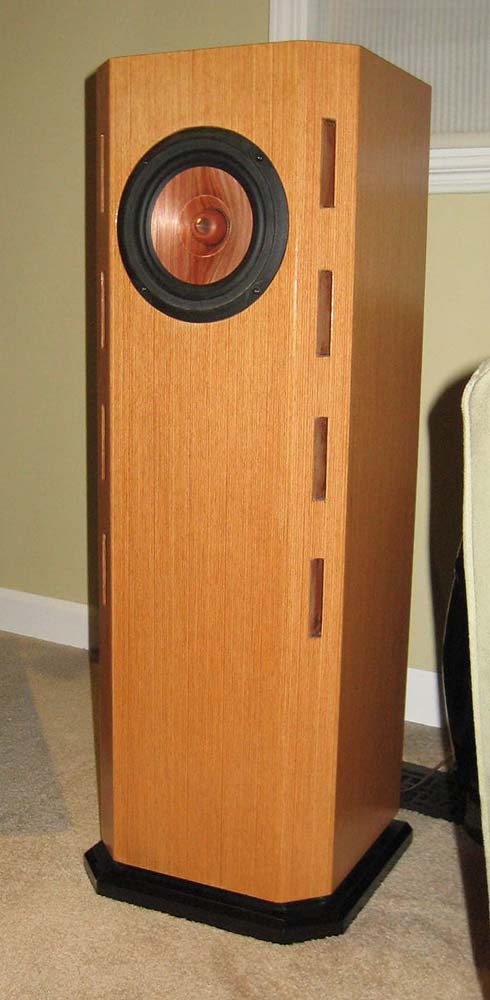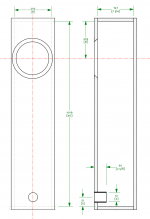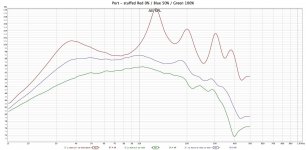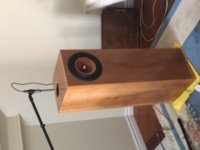Hello,
I have built a TQWT cabinet of about 3 cubic feet internal volume and stuffed it with 1.5 lbs long fiber wool (evenly distributed). This follows the recommendations found in this forum of 0.5 lb per cubic foot. However I find the bass response to be anemic. Could I have over stuffed the cabinet and if so would that affect bass response?
8 inch woofer Fs is 40 Hz. (cabinet tube is based on 40 Hz quarter wavelength) Xmax = 1 mm, Qts 0.351
Thanks!
Dean
I have built a TQWT cabinet of about 3 cubic feet internal volume and stuffed it with 1.5 lbs long fiber wool (evenly distributed). This follows the recommendations found in this forum of 0.5 lb per cubic foot. However I find the bass response to be anemic. Could I have over stuffed the cabinet and if so would that affect bass response?
8 inch woofer Fs is 40 Hz. (cabinet tube is based on 40 Hz quarter wavelength) Xmax = 1 mm, Qts 0.351
Thanks!
Dean
sure, i am not sure in your case but acoustic damping can be overdone, if the density gets too high then the damping material starts to reflect sounds
if that happens the box acts smaller then it is, that usually means reduced low freq output but a boosted midwoofer output
if that happens the box acts smaller then it is, that usually means reduced low freq output but a boosted midwoofer output
Short answer. Yes.
In a TL we have a fundemental resonance that we (usually) want to take advantage of and a bunch of harmonics we don’t want.
Traditionally stuffing has been used to create the necessary low pass filter on the terminus. But with volume stuffing one has to choose a compromise between maximizing the fundemental and losing all the harmonics.
Modern TL modelers have brought us some new tools in this battle, in particular mass-loading and driver offset. Both need to be used in a Voigt (TQWT) pipe to get good bass. Every line has a specific damping density for the line, your room, your tastes, and your amplifier.
A Voigt (or any TL) really needs to be designed specifically for the driver. What is your driver, and the dimensions of your Voigt?
The information you have provided so far is insufficient to tell us much.
Also, wool tends to have higher damping levels than the synthetic stuffing materials more commonly used. It also sags, and i recommend mixing it half & half with something like acoustastuff so that it stays in place.
dave
In a TL we have a fundemental resonance that we (usually) want to take advantage of and a bunch of harmonics we don’t want.
Traditionally stuffing has been used to create the necessary low pass filter on the terminus. But with volume stuffing one has to choose a compromise between maximizing the fundemental and losing all the harmonics.
Modern TL modelers have brought us some new tools in this battle, in particular mass-loading and driver offset. Both need to be used in a Voigt (TQWT) pipe to get good bass. Every line has a specific damping density for the line, your room, your tastes, and your amplifier.
A Voigt (or any TL) really needs to be designed specifically for the driver. What is your driver, and the dimensions of your Voigt?
The information you have provided so far is insufficient to tell us much.
Also, wool tends to have higher damping levels than the synthetic stuffing materials more commonly used. It also sags, and i recommend mixing it half & half with something like acoustastuff so that it stays in place.
dave
Keep the stuffing away from the open end of the line to maximize the fundamental. Stuffing material towards the closed end has a less damping effect on the fundamental, while it remains effective for the fundamentals.
What woofer do you use? The xmax of 1 mm suggests that it has a high fs, which is another explanation for the lack of bass.
What woofer do you use? The xmax of 1 mm suggests that it has a high fs, which is another explanation for the lack of bass.
Planet10 - if a TL is over stuffed, would the response revert to something like aperiodic damped response?
Reverting briefly to the OP -what is / are the line cross sections, i.e. throat & terminus area, and any vent area if applicable?
Planet10 - if a TL is over stuffed, would the response revert to something like aperiodic damped response?
That is exactly what an aperiodic TL is. All that length means more distance for the back wave to travel and be”completely” absorbed.
One of my gurus did reserch (that i should have, but haven’t found) that one can get response that rolls off slower than sealed (just initially), and has less phase rotation. I’ll se eif i canreaquire that research.
The new TL modelers have shown us that there are a much wider range of possibke TL designs, from those that approach aperiodic to those that have response shape similar to BR (but lower in frequency)
dave
If the particular design intent was aiming for an aperiodic result then the enclosure isn't "overstuffed"... it's stuffed "just right" -- Goldilocks
I imagine that, depending on the chosen objective implementations might be relatively overstuffed without these necessarily approaching "aperiodic". Or under stuffed and approaching some other alignment. Right?
I imagine that, depending on the chosen objective implementations might be relatively overstuffed without these necessarily approaching "aperiodic". Or under stuffed and approaching some other alignment. Right?
Good analysis Mr H.
What the original design intent was determines where the terms used in your second sentence determine were they fall on a more quantitative scale. Relativity. Context.
dave
What the original design intent was determines where the terms used in your second sentence determine were they fall on a more quantitative scale. Relativity. Context.
dave
Some questions were asked regarding the driver and Voigt design.
Cabinet design used the following calculator:
Volume Calculator for Closed Cabinets
Cabinet dimensions are based on driver specifications input to the calculator.
Driver is made by Airborne. Specs are here:
https://solen.ca/wp-content/uploads/fr222b819f.pdf
Internal cabinet dimensions are 92 cm high, 28.8 cm deep 23 cm wide.
Cross sectional area throat: about 340 square centimetres.
Cross sectional area is about 79 square centimetres.
I have looked for a TL simulator software on line. Mr. King's spreadsheets are no longer available. There is a fence,an put of the UK who designed some software but it is windows only. I am in a Mac/ Linux environment, so suggestions are welcome.
Cabinet design used the following calculator:
Volume Calculator for Closed Cabinets
Cabinet dimensions are based on driver specifications input to the calculator.
Driver is made by Airborne. Specs are here:
https://solen.ca/wp-content/uploads/fr222b819f.pdf
Internal cabinet dimensions are 92 cm high, 28.8 cm deep 23 cm wide.
Cross sectional area throat: about 340 square centimetres.
Cross sectional area is about 79 square centimetres.
I have looked for a TL simulator software on line. Mr. King's spreadsheets are no longer available. There is a fence,an put of the UK who designed some software but it is windows only. I am in a Mac/ Linux environment, so suggestions are welcome.
I have looked for a TL simulator software on line. Mr. King's spreadsheets are no longer available. There is a fence,an put of the UK who designed some software but it is windows only. I am in a Mac/ Linux environment, so suggestions are welcome.
Hornresp runs in Wine.
I must say that, without measurements, this is not a clear description of your issue. Measure driver and port at about 0.2m distance each (don't change sensitivity settings) and publish the result, I'd say.However I find the bass response to be anemic.
fr222b819f
Designing ny Voigt (AKA TL) requires a proper box quarter-wave modeler.
The on-line TL & Voigt calculators aren’t worth the electrons they are made of.
Here is an ML-TL.
We built a set of miniOnkens for the 6.5” version of these Solen house brands. They were quite good (i have a pair of the same in my growin gpile to get out the door).

dave
Attachments
Lol.The on-line TL & Voigt calculators aren’t worth the electrons they are made of.
I should add, quick & dirty as i left out lost of detail including a holey drace from the baffle to the back and maybe a couple strubs at the bottom. That will increase the gross width a bit to accomodate for the brace volume. That has th eside efect of giving the back of the driver a bit more room.
Damping is Woden-standard.
dave
Damping is Woden-standard.
dave
one can get response that rolls off slower than sealed (just initially), and has less phase rotation
Rick's Alpha TL [Fs/Qts'] IIRC.
Qts' = Qts + any added series resistance [Rs]: Calculate new Qts with Series Resistor
Update: overstuffed transmission line
Here is a summary of what I have done and learned so far. Thanks to all for your responses.
So, I built a set of transmission lines using a full range driver. These things get stuffed with long fibre wool to act as a filter for the upper mid frequencies as the sound passes through the transmission line.
After a break in period, I found the bass was anemic. Not at all what I would expect from a set of transmission line speakers. I did a fair bit of research and got to wondering whether I had overstuffed the cabinet. It turns out I had miscalculated the internal volume so I had indeed overstuffed it by about a third. I spent Friday pulling out the excess stuffing, and after listening concluded the bass was noticeably improved.
Yesterday my buddy came over, and we went through a series of frequency measurements.
When we ran our frequency response sweeps on the driver itself we noticed a significant dip in the 50 to 100 Hz region. I had read some research suggesting that one need not stuff the entire transmission line, but only the first half. So, we did an experiment.
The port response with all of the stuffing removed showed quite noticeable oscillations due to internal cabinet reflections.
When the cabinets stuffed along the entire length of the transmission line with a density of 0.5 pounds per cubic foot, the internal cabinet reflections are now gone, but in the 50 to 100 Hz range and there is a fair bit of rolloff.
When only the first half of the transmission line is stuffed with wool (with the second half of the line is completely empty), the improvement in bass response is considerable, (about 6 db louder) and the graph is flatter. So, in conclusion at least for this particular driver, one need not stuff the transmission line completely.
Not only that, but when we did a full sweep of the driver, the graph we got very closely matched what was published by the manufacturer. This proves that our equipment is working correctly, and the driver is behaving as the manufacturer states.
Many thanks to my buddy for the opportunity to do this and basically tweak the results of my speaker design.
Dean
Here is a summary of what I have done and learned so far. Thanks to all for your responses.
So, I built a set of transmission lines using a full range driver. These things get stuffed with long fibre wool to act as a filter for the upper mid frequencies as the sound passes through the transmission line.
After a break in period, I found the bass was anemic. Not at all what I would expect from a set of transmission line speakers. I did a fair bit of research and got to wondering whether I had overstuffed the cabinet. It turns out I had miscalculated the internal volume so I had indeed overstuffed it by about a third. I spent Friday pulling out the excess stuffing, and after listening concluded the bass was noticeably improved.
Yesterday my buddy came over, and we went through a series of frequency measurements.
When we ran our frequency response sweeps on the driver itself we noticed a significant dip in the 50 to 100 Hz region. I had read some research suggesting that one need not stuff the entire transmission line, but only the first half. So, we did an experiment.
The port response with all of the stuffing removed showed quite noticeable oscillations due to internal cabinet reflections.
When the cabinets stuffed along the entire length of the transmission line with a density of 0.5 pounds per cubic foot, the internal cabinet reflections are now gone, but in the 50 to 100 Hz range and there is a fair bit of rolloff.
When only the first half of the transmission line is stuffed with wool (with the second half of the line is completely empty), the improvement in bass response is considerable, (about 6 db louder) and the graph is flatter. So, in conclusion at least for this particular driver, one need not stuff the transmission line completely.
Not only that, but when we did a full sweep of the driver, the graph we got very closely matched what was published by the manufacturer. This proves that our equipment is working correctly, and the driver is behaving as the manufacturer states.
Many thanks to my buddy for the opportunity to do this and basically tweak the results of my speaker design.
Dean
Attachments
- Home
- Loudspeakers
- Multi-Way
- Can overstuffing a TL reduce bass output?


